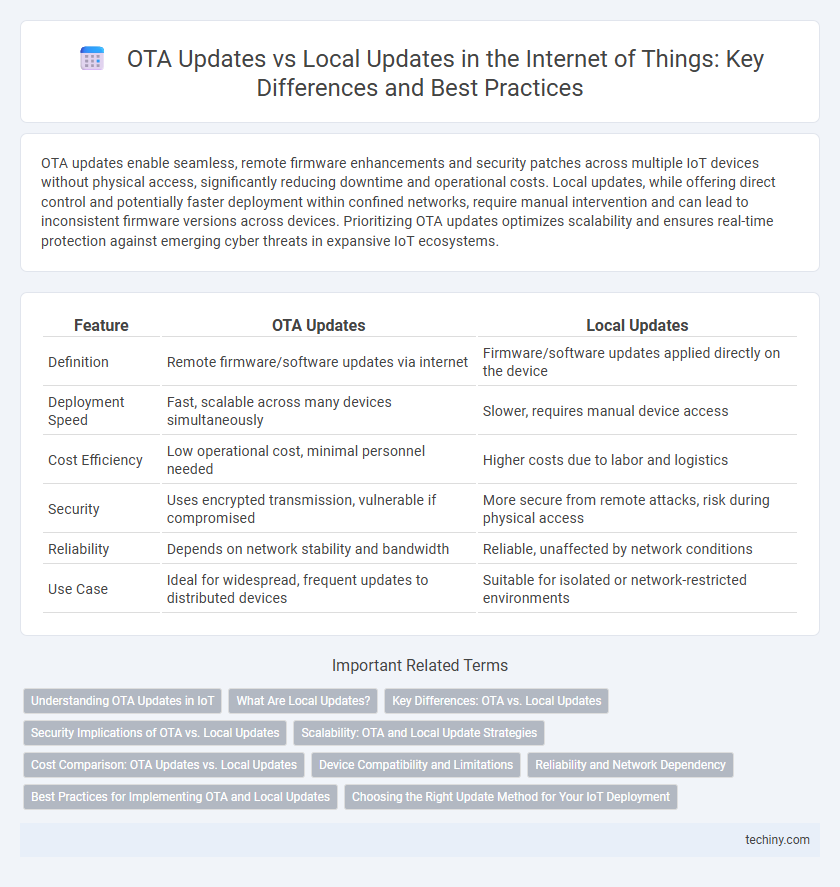OTA updates enable seamless, remote firmware enhancements and security patches across multiple IoT devices without physical access, significantly reducing downtime and operational costs. Local updates, while offering direct control and potentially faster deployment within confined networks, require manual intervention and can lead to inconsistent firmware versions across devices. Prioritizing OTA updates optimizes scalability and ensures real-time protection against emerging cyber threats in expansive IoT ecosystems.
Table of Comparison
| Feature | OTA Updates | Local Updates |
|---|---|---|
| Definition | Remote firmware/software updates via internet | Firmware/software updates applied directly on the device |
| Deployment Speed | Fast, scalable across many devices simultaneously | Slower, requires manual device access |
| Cost Efficiency | Low operational cost, minimal personnel needed | Higher costs due to labor and logistics |
| Security | Uses encrypted transmission, vulnerable if compromised | More secure from remote attacks, risk during physical access |
| Reliability | Depends on network stability and bandwidth | Reliable, unaffected by network conditions |
| Use Case | Ideal for widespread, frequent updates to distributed devices | Suitable for isolated or network-restricted environments |
Understanding OTA Updates in IoT
OTA updates in IoT enable remote software enhancements, improving device functionality and security without physical intervention. This method reduces downtime and operational costs by delivering patches, firmware upgrades, and configuration changes over the air. Local updates require manual device access, increasing labor and limiting scalability, making OTA a preferred choice for large IoT deployments.
What Are Local Updates?
Local updates refer to the process of updating IoT device firmware or software directly on-site without relying on internet connectivity, often using physical interfaces such as USB drives, Bluetooth, or local networks. These updates provide enhanced security by minimizing exposure to potential remote cyber-attacks and offer quicker deployment in environments with limited or no internet access. Local updates are critical for industrial IoT settings where reliability and immediate patching of devices like sensors, controllers, and gateways ensure uninterrupted operational performance.
Key Differences: OTA vs. Local Updates
OTA updates enable seamless, remote firmware upgrades across IoT devices via wireless networks, ensuring minimal downtime and centralized control. Local updates require physical access or direct connections to devices, posing challenges for scalability and rapid deployment in widespread IoT ecosystems. Security protocols differ as OTA updates depend heavily on encrypted, authenticated transmissions to prevent remote attacks, whereas local updates rely more on controlled access and manual verification.
Security Implications of OTA vs. Local Updates
OTA updates enable remote patching of IoT devices, reducing exposure time to vulnerabilities by delivering timely security fixes directly through encrypted communication channels. Local updates require physical access, limiting the risk of remote interception but increasing potential threats from insider tampering or unattended devices during the update process. Ensuring robust authentication and integrity verification mechanisms is critical in both OTA and local update methods to prevent unauthorized code execution and maintain device trustworthiness.
Scalability: OTA and Local Update Strategies
OTA updates enable scalable management of thousands of IoT devices by delivering firmware patches remotely via cloud platforms, minimizing physical intervention and deployment time. Local updates require manual interaction or side-loading through physical connections, which severely limits scalability in large or distributed IoT networks. Efficient OTA update mechanisms reduce downtime and operational costs, making them essential for managing extensive IoT ecosystems.
Cost Comparison: OTA Updates vs. Local Updates
OTA updates significantly reduce operational costs by eliminating the need for physical technician visits and hardware logistics, making them more scalable for large IoT deployments. Local updates, while potentially faster for individual devices, incur higher labor and transportation expenses, which escalate with device quantity and geographic distribution. Analyzing total cost of ownership reveals OTA updates optimize expenses in maintenance, downtime, and workforce allocation for extensive IoT ecosystems.
Device Compatibility and Limitations
OTA updates enable seamless device compatibility across diverse IoT environments by remotely delivering firmware patches, but they may face limitations such as dependency on stable internet connectivity and potential security risks during transmission. Local updates offer better control over device-specific configurations and work efficiently in isolated networks without internet access, yet they often require manual intervention and physical proximity to the device. Balancing OTA and local update strategies is crucial for optimizing IoT device performance while addressing compatibility challenges and operational constraints.
Reliability and Network Dependency
OTA updates in Internet of Things devices offer the advantage of remote deployment, enhancing scalability but relying heavily on stable network connectivity, which can impact reliability during interruptions. Local updates provide greater reliability by eliminating dependency on internet access, ensuring devices can be updated in isolated or network-constrained environments. Choosing between OTA and local updates requires balancing the need for consistent network availability with the demand for uninterrupted device functionality.
Best Practices for Implementing OTA and Local Updates
Implementing OTA updates in IoT devices requires secure encryption protocols and robust authentication mechanisms to prevent unauthorized access and ensure data integrity. Local updates demand strict physical access controls and reliable fallback procedures to avoid device bricking during firmware installation. Both methods benefit from incremental update strategies and comprehensive logging to enhance update efficiency and traceability in IoT ecosystems.
Choosing the Right Update Method for Your IoT Deployment
Selecting the optimal update method for your IoT deployment hinges on factors like network reliability, device scalability, and security requirements. OTA updates provide seamless remote management and scalability for large fleets, while local updates offer enhanced control and reduced latency in environments with limited connectivity. Evaluating device capabilities, operational constraints, and risk tolerance ensures the chosen update strategy maximizes efficiency and minimizes downtime.
OTA updates vs Local updates Infographic

 techiny.com
techiny.com